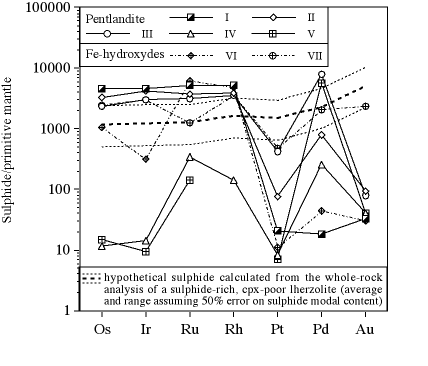Luguet A.1, Alard O.2, Lorand J.P.1, Pearson N.J.2, Ryan C.G.3 and O'Reilly
S.Y.2.
1. Laboratoire de Minéralogie, ESA 7058, MNHN, 75005 Paris,
France, 2. GEMOC, Macquarie,
3. CSIRO Exploration and Mining
A comprehensive study of dredged abyssal peridotites from the Kane fracture
zone has been undertaken using high-quality whole-rock ICP-MS data, LAM-ICPMS
analyses of sulphides and SEM and NMP data. The studied samples are partial
melting residues (1.5<Al2O3 wt% <3.2; 6<F<18%); however, the
clinopyroxene displays a wide range of textures that reflect the incomplete
extraction of partial melts (Seyler et al., submitted). They all contain
magmatic sulphides either intergranular sulphides (pentlandite and minor
serpentinization-derived phases) or minute Ni- and Cu-rich inclusions (pentlandite,
chalcopyrite, bornite) in corroded opx and cpx (Luguet and Lorand, 1999).
Seafloor weathering produced iron hydroxides from magmatic sulphides. Magmatic
sulphide grains are heterogeneously distributed on all scales, irrespective
of fertility indices; cpx-poor lherzolites define a sulphide enrichment
trend (up to 110 magmatic grains per polished thin section) that testifies
sulphide precipitation from melts en route to the surface during adiabatic
partial melting.
Whole-rock data indicate broadly chondritic PGE ratios except for RuN/IrN
(1.2; N = CI-chondrite normalized) and Pd/Ir which varies by a factor 10.
Harzburgites are Pd-depleted (PdN/IrN = 0.31-0.48), in agreement with the
incompatible behaviour of Pd in mantle melting processes. SEM and NMP data
reveal primary Os-Ru-Ir alloys which could account for the compatible behaviour
of these elements. By contrast, PdN/IrN (and PtN/IrN too) increases from
the lherzolites (0.27-0.81) to the cpx-poor lherzolites (0.68-2.04). Both
ratios positively correlate with sulphide modal contents. These correlations
provide unequivocal evidence that immiscible sulphide precipitated in the
mantle column during adiabatic partial melting may alter whole-rock PGE
ratios (c.f. Rehkämper et al., 1999).

LAM-ICPMS analyses indicate high PGE concentrations in pentlandite, the only sulphide large enough to be analysed (Fig. 1). As noted in previous works (c.f. Ballhaus and Sylvester, 2000), pentlandite concentrates Os (up to 65 ppm), Ir (up to 53 ppm), Ru (up to 101 ppm), Rh (up to 17 ppm) and Pd (up to 56 ppm). However, the Pt and Pd concentration range spans several orders of magnitude. NMP images reveal discrete areas containing up to several percents Pd and Ag. Pt and Pd vary sympathetically although Pt is systematically depleted relative to Pd and the other PGE (<6 ppm). The huge variation of Pt and Pd contents determine several primitive-mantle normalized PGE patterns. Patterns I and II are Pt- and Pd-depleted (PtN/IrN =0.02; PdN/IrN=0.007-0.34) and may correspond to sulphides that are residual from large melting degrees. Pattern III, characterized by suprachondritic PdN/IrN (4.3) is indisputably of late-precipitation origin. It has been identified mostly in pentlandite grains adjacent to refertilization cpx. Note that the weathered grains (VI and VII) analysed differ from the unaltered sulphides, only by high Au contents and some scatter in their Ir and Ru relative abundances. Also characteristic of sulphide-rich, cpx-poor lherzolites, patterns IV and V are characterized by lower compatible PGE contents coupled with highly fractionated PdN/IrN (15 - 505) and Pd contents of pentlandite (up to 50 ppm). These patterns probably correspond to pentlandite and chalcopyrite finely intergrown with pentlandite. Fig. 1 also shows that whole-rock PGE abundances (stippled area) can be satisfactorily balanced by combining pattern III with patterns IV and V in subordinate amounts. In no case, however, can platinum and gold be accounted for by magmatic sulphides. Gold may be located in sulphide weathering products. SEM and NMP scanning has not yet revealed any Pt-rich discrete phase, either associated with magmatic sulphides or disseminated in matrix silicates or spinel. If present, such phases are likely to occur at the sub-micron scale; care must therefore be exercised in using sulfide-silicate partition coefficients for modelling the behaviour of Pt in the oceanic mantle.
REFRENCES :
Ballhaus, C. and Sylvester, P., 2000. J.Pet., 41, 545-556.
Luguet, A. and Lorand, J.P., 1999. C.R. Acad. Sci., Série II,
329, 637-644.
Rehkämper, M., Halliday, A.N., Alt, J., Fitton, J.G., Zipfel,
J. and Takazawa, E., 1999. Earth Planet. Sci. Lett.,172; 65-81.

 GEMOC ARC National Key Centre
GEMOC ARC National Key Centre